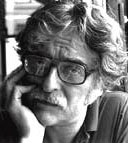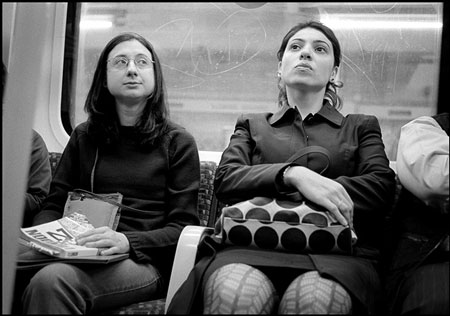 |
→ December 2004 Contents → Column
|
Nuts & Bolts
December 2004
|
 |
|
Street photography has always been the province of small and less attention-grabbing cameras. In the early days of 35mm, those who felt those little cameras couldn't be trusted opted for Rolleis rather than sheet film cameras. When 35mm took over, rangefinders became the cameras of choice as SLRs grew larger and larger. And when point-and-push cameras with top optics and mechanics appeared, a number of photographers quietly switched to them - producing "professional" pictures with "amateur" cameras.
But the digital photographer looking for similar small cameras is often told that the non-SLR, "prosumer" digital cameras don't have the image quality for serious "professional" work. Nonsense!!!
I routinely print uncropped images from two "prosumer" cameras, the Leitz Digilux II and the Canon Powershot Pro 1, on 11x14- and 13x19-inch paper. When I show these prints, they are usually mixed with prints of the same size from larger digital SLRs. No one, including other photographers, notices the technical differences. They are there if you look for them in large, matched comparison prints. But they are simply not significant in street photography. They are not significant in film photography, and they are not significant in digital photography. If they were, my neurologist would be a better photographer than Cartier-Bresson, Frank and Erwitt.
That is not to say that the small digital cameras do not have specific problems. The small sensor (the equivalent of the 28mm lens on a 35mm camera is a 7.5 mm lens) can produce a "noisy" image at higher film speeds. That means shooting at an EI equivalent of 50 or 100 for the best results. In fact, one of my objections to the Digilux is that the lowest equivalent is 100. The Canon Powershot lets me shoot at 50.
If that sounds strange, remember that many of us grew up shooting color photojournalism with Kodachromes of 25 and 64. You learned a lot about holding cameras steady, but you sold more pictures than the folks who were using High-Speed Ektachrome. Still, when I'm shooting in the subway or underground, and need a film speed of 1600, I'm back to film in a point-and-push. But, fortunately, most street photography occurs above ground.
The other problems faced by users of these "prosumer" digital cameras is the delay between pushing the button and taking the picture. With some cameras used improperly, it can take almost two seconds between the time you start the process and the time the shutter goes off. That is horrifying. Used this way, these cameras don't take pictures; they make guesses. It's sort of the "Indecisive Moment - maybe."
While the delay situation seems to be improving with each generation of digital point-and-push, there are steps that always need to be taken.
Most of the automatic camera settings are made when the shutter button is depressed halfway. In any picture-taking situation, make sure that step is taken well in advance of the final push and click.
A great deal of that initial lag is taken up in auto focusing. Most of the time, when I'm shooting on the street, I have preset a manual focusing distance. That's true whether I'm shooting film or digital, rangefinder, SLR or point-and-push. Regardless of how you choose to focus, there just isn't time on the street to see a possible picture, focus and, then, take the picture. Prefocus, prefocus, prefocus.
Having done that, check out the various exposure modes (program, f/stop priority, manual) to see if one of them minimizes the delay. If it turns out to be manual, don't worry too much. Remember, considerably more great street pictures have been taken on manual than program. And we don't call those less-than-perfect exposures mistakes; we call them individual, creative decisions. Have you noticed that since totally automatic cameras appeared, a lot of photographs have started to look alike? Should we be crediting the camera rather than the photographer? "Photo by Canon 10D" or "Copyright Leitz Digilux II, 2004."
I think that I have the shooting delays on my systems down to about a tenth or eighth of second. It's not something I have set out to measure. But, taking the above precautions, I have no more action-timing problems than I had with the earliest film SLRs or some of today's film SLRs in their most automated modes. I'm seeing too much good candid photography with small digital cameras to think that my opinion is the blind spot of someone who shot sports with a Visoflex.
A friend of mine, working on a book that is essentially street photography, added a Digilux to this camera bag (Leica M7, Rolleiflex) for the last few trips he made to shoot pictures. Now that the layout is done, he discovers that 35 percent to 40 percent of the selects were made with the digital. By the way, while he was shooting, each night he was sending the digital images to his art director for review. Quite often his books result in exhibitions. We'll be looking at film and digital photography side by side on both book pages and walls. It will be interesting to see viewers' reactions. I seriously doubt if they will have anything to do with what kind of camera took the picture. I'll let you know.
 When I'm shooting in the subway or underground, and need a film speed of 1600, I'm back to film in a point-and-push.
 Fortunately, most street photography occurs above ground.
© Bill Pierce
Contributing Writer
|
|
Back to December 2004 Contents
|
|